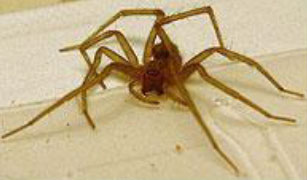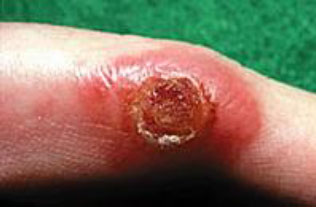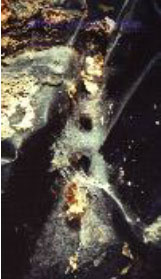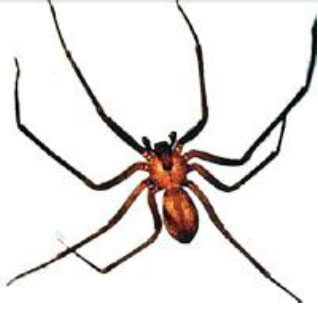Identify a Hobo Spider
 Hobo Spiders are brown and measure roughly 12 to 18 mm in length. Their legs show no distinct rings and have short hairs. Their abdomens have several chevron shaped markings. Males are distinctively different from females in that they have two large palps that look like boxing gloves. These palps are often mistaken for fangs or venom sacs, but they are in fact the male genitalia. The females also have these palps, but the ends are not 'swollen' as they are on the males. Females tend to have a larger abdomen when compared to males.
Hobo Spiders are brown and measure roughly 12 to 18 mm in length. Their legs show no distinct rings and have short hairs. Their abdomens have several chevron shaped markings. Males are distinctively different from females in that they have two large palps that look like boxing gloves. These palps are often mistaken for fangs or venom sacs, but they are in fact the male genitalia. The females also have these palps, but the ends are not 'swollen' as they are on the males. Females tend to have a larger abdomen when compared to males.
Where did they come from?
 Tegenaria agrestis, also called the Hobo Spider as well as the Aggressive House Spider (AHS), has been suspected of presiding in the United States as early as the 1920's and 1930's. Originally from Europe, the Hobo Spider is a species foreign to the United States. They are believed to have been transported to the United States via shipping lanes and ended up in Seattle, Washington. Since then they have slowly expanded throughout the Northwestern United States and Western Canada. Despite their increasing range and population, public awareness of these spiders has been surprisingly low, primarily because the Brown Recluse Spider has been inaccurately blamed for the bites that people receive from Hobo Spiders.
Tegenaria agrestis, also called the Hobo Spider as well as the Aggressive House Spider (AHS), has been suspected of presiding in the United States as early as the 1920's and 1930's. Originally from Europe, the Hobo Spider is a species foreign to the United States. They are believed to have been transported to the United States via shipping lanes and ended up in Seattle, Washington. Since then they have slowly expanded throughout the Northwestern United States and Western Canada. Despite their increasing range and population, public awareness of these spiders has been surprisingly low, primarily because the Brown Recluse Spider has been inaccurately blamed for the bites that people receive from Hobo Spiders.
How can I control them?
Experts on dangerous spiders in North America agree that pre-baited traps are the most effective means available to control Hobo Spider populations. Bug bombs and pesticides have proven highly ineffective against them and, in fact, are prone to help them because they result in killing their natural predatory spiders, allowing their population to expand unhindered!
What does their bite look like?
 To the left is a picture of a Hobo Spider bite. About 50% of Hobo Spider bites are 'dry,' meaning that no venom is injected and nothing happens to the victim. In fact, often times the victim does not even realize that he has been bit. Typically, when venom is injected, the victim will experience an immediate redness which develops around the bite then begins to disappear within a few hours. Very often, for the first 24 hours, the bite appears to be no worse than that of a mosquito; then it begins to blister in the center. Within 24 to 36 hours the blister breaks open, leaving an open, oozing ulceration.
To the left is a picture of a Hobo Spider bite. About 50% of Hobo Spider bites are 'dry,' meaning that no venom is injected and nothing happens to the victim. In fact, often times the victim does not even realize that he has been bit. Typically, when venom is injected, the victim will experience an immediate redness which develops around the bite then begins to disappear within a few hours. Very often, for the first 24 hours, the bite appears to be no worse than that of a mosquito; then it begins to blister in the center. Within 24 to 36 hours the blister breaks open, leaving an open, oozing ulceration.
This ulceration 'scabs' over within three weeks from the initial bite, leaving a permanent scar. If the bite is delivered in fatty tissue, the lesion may be very deep and extensive, not healing for over two or three years. Systematic reactions to Hobo Spider poisoning include severe headaches, nausea, vomiting, soreness and flu-like symptoms. In extreme cases where the bite was not taken care of early, skin graft, amputation, and the possibility of bone marrow failure may occur.
Are Hobo Spiders Brown Recluse Spiders?
For years there have been numerous reports of spider bites in the Northwest United States in which the Brown Recluse Spider was blamed, despite the fact that they reside in the Mid-Southern to Southeast United States. Brown Recluse Spiders have bite effects and symptoms that are nearly identical to Hobo Spiders.Because the Brown Recluse Spider is known more throughout the general population, they had been, and still are today, wrongfully accused of the insidious effects of Hobo Spider bites. Our traps are recommended for Brown Recluse Spiders as well.

What does the Hobo's Web look like?
The hobo spider creates a non-sticky (in spider standards) trip web that doesn't permanently stick insects to the web. Instead, once the prey trips on the web the hobo spider attacks the prey before it can get away. This along with its poor eye site explains why they are noticeably more aggressive to humans then other spiders. They have to attack to eat otherwise they would die of starvation. The webs they make are funnel shaped and are often attached to an object in the yard, by the foundation, between planters, or anything that remains stationary near ground level. They also make webs under the siding of homes and attaching to plants or weeds. Here is an example of a large hobo spider web(20% of actual size). Most webs are not as obvious and large, this picture was taken between 2 planters for new trees.
